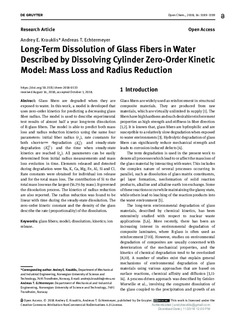| dc.contributor.author | Krauklis, Andrey | |
| dc.contributor.author | Echtermeyer, Andreas | |
| dc.date.accessioned | 2019-02-18T16:10:16Z | |
| dc.date.available | 2019-02-18T16:10:16Z | |
| dc.date.created | 2018-11-27T15:22:40Z | |
| dc.date.issued | 2018 | |
| dc.identifier.citation | Open Chemistry. 2018, 16 (1), 1189-1199. | nb_NO |
| dc.identifier.issn | 2391-5420 | |
| dc.identifier.uri | http://hdl.handle.net/11250/2586073 | |
| dc.description.abstract | Glass fibers are degraded when they are exposed to water. In this work, a model is developed that uses zero-order kinetics for predicting a decreasing glass fiber radius. The model is used to describe experimental test results of almost half a year long-term dissolution of R-glass fibers. The model is able to predict both mass loss and radius reduction kinetics using the same four parameters: initial fiber radius (r0), rate constants for both short-term degradation (KI0)and steady-state degradation (KII0)and the time when steady-state kinetics are reached (tst). All parameters can be easily determined from initial radius measurements and mass loss evolution in time. Elements released and detected during degradation were Na, K, Ca, Mg, Fe, Al, Si and Cl. Rate constants were obtained for individual ion release and for the total mass loss. The contribution of Si to the total mass loss was the largest (56.1% by mass). It governed the dissolution process. The kinetics of radius reduction are also reported. The radius reduction was found to be linear with time during the steady-state dissolution. The zero-order kinetic constant and the density of the glass describe the rate (proportionality) of the dissolution. | nb_NO |
| dc.language.iso | eng | nb_NO |
| dc.publisher | De Gruyter | nb_NO |
| dc.rights | Attribution-NonCommercial-NoDerivatives 4.0 Internasjonal | * |
| dc.rights.uri | http://creativecommons.org/licenses/by-nc-nd/4.0/deed.no | * |
| dc.title | Long-Term Dissolution of Glass Fibers in Water Described by Dissolving Cylinder Zero-Order Kinetic Model: Mass Loss and Radius Reduction. | nb_NO |
| dc.title.alternative | Long-Term Dissolution of Glass Fibers in Water Described by Dissolving Cylinder Zero-Order Kinetic Model: Mass Loss and Radius Reduction. | nb_NO |
| dc.type | Journal article | nb_NO |
| dc.type | Peer reviewed | nb_NO |
| dc.description.version | publishedVersion | nb_NO |
| dc.source.pagenumber | 1189-1199 | nb_NO |
| dc.source.volume | 16 | nb_NO |
| dc.source.journal | Open Chemistry | nb_NO |
| dc.source.issue | 1 | nb_NO |
| dc.identifier.doi | 10.1515/chem-2018-0133 | |
| dc.identifier.cristin | 1635905 | |
| dc.description.localcode | © 2018 Andrey E. Krauklis, Andreas T. Echtermeyer, published by De Gruyter. This work is licensed under the Creative Commons Attribution-NonCommercial-NoDerivatives 4.0 License. BY-NC-ND 4.0 | nb_NO |
| cristin.unitcode | 194,64,92,0 | |
| cristin.unitname | Institutt for maskinteknikk og produksjon | |
| cristin.ispublished | true | |
| cristin.fulltext | original | |
| cristin.qualitycode | 1 | |

